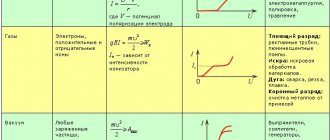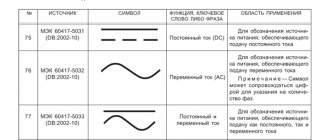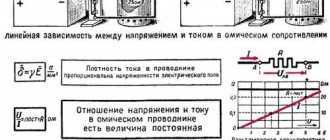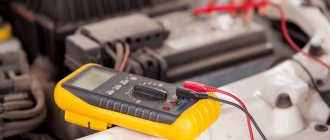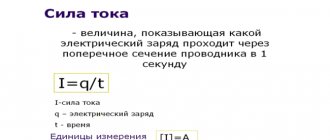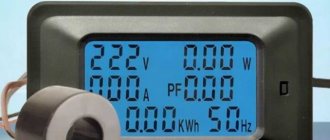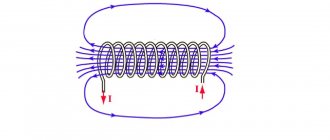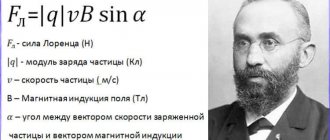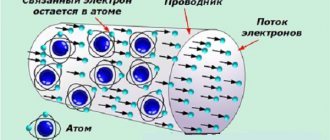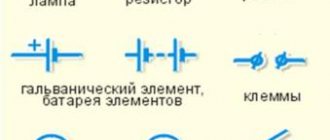Under what conditions does electric current occur and what is current strength in simple words
Let me immediately draw your attention: the definition of electric current does not apply to static, frozen phenomena. It is directly related to movement, a dynamic state.
It is created not by neutral, but by active particles of positive or negative electrical charge.
And they should not move chaotically, like residents of a metropolis during rush hour, but in a directional manner. Example: movement of a mass of cars along a multi-lane road in one direction in a large city.
Have you presented the picture? Cars from the side are added inside the continuous flow, some drivers move off the highway onto other roads. But these processes do not particularly affect the overall movement: the direction remains one-sided.
The movement of electric charges also occurs. Electrons create current inside metal conductors. In the normal state, they move there quite chaotically in all directions.
But as soon as an external force of electrical voltage is applied to them with positive and negative potentials at opposite ends of the conductor, the directed movement of charges begins.
It is an electric current. I draw your attention to the last word. It characterizes flow, movement, movement, dynamics and related processes, but not statics.
It is the magnitude of the applied external force that determines the quality of the directional flow of electrons in one direction. The higher its value, the greater the current begins to flow through the conductor.
However, here you need to take into account several features related to:
- generally accepted scientific conventions;
- intensity of movement of charges;
- Reaction from the internal environment of the conductor.
In the first case , we have to overcome established historical stereotypes when people confuse the general direction of electrons and electric current.
All scientific calculations are based on the fact that the direction of the current is taken to be the movement of charged particles from the plus of the voltage source to its minus.
Inside metals, an electric current is created by moving electrons in the opposite direction: they are repelled from the negative pole of the same name and move towards the positive one.
Misunderstanding of this provision may lead to errors. But they are easy to avoid: you just need to remember this feature and use it when calculating or analyzing the actions of electrical circuits.
The intensity of movement of charged particles is characterized by the amount of their charge flowing through a given area in a certain period of time.
It is called the current strength, denoted by the Latin letter I, and calculated by the ratio ∆Q/∆t.
Here ∆Q is the number of charges passing through a conductor of area S and length ∆L, and ∆t is a calibrated time interval.
To increase the current, we need to increase the number of charges passing through the conductor per unit time, and to decrease it, reduce it.
Again, take a closer look at the term “current strength”, or rather at its first word. I specifically showed a powerful biceps and a smoldering light bulb for comparison in the very top picture.
The power reserve of an energy source can vary from excessive to insufficient for the consumer. And we always need to power the load optimally. For this purpose, the concept of current strength was introduced.
To evaluate it, a unit of measurement is used: ampere, denoted by the Latin letter A.
Theoretically, to estimate 1 ampere you need:
- take two very thin, infinitely long and completely smooth conductors;
- place them on a plane strictly parallel to each other at a distance of 1 meter;
- pass the same current through them, gradually increasing its value;
- measure the force of attraction of the wires and record the moment when it reaches a value of 2 × 10-7 Newton.
That’s when 1 ampere will begin to flow in the wires.
In practice, no one does this. Special instruments have been created for measurement: ammeters. Their designs work in length and multiplicity sizes: milli-, micro- and kilo-.
Another definition of ampere is related to the unit of quantity of electricity: the coulomb (C) that passes through the cross-section of a wire in 1 second.
1A = 1Kl / 1c
The strength of the current anywhere in a closed electrical circuit where it flows is always the same , and when it breaks, wherever it is, it disappears.
This phenomenon allows you to take measurements in the most convenient places of any electrical circuit.
When a complex branched circuit is created for the flow of several currents, the latter also remain constant in all individual sections.
The third case of environmental resistance is also important. As electrons move, they encounter obstacles in the form of positively and negatively charged particles.
Such collisions are associated with the expenditure of energy spent on heat generation. They were generalized by the term electrical resistance and described by physical laws in mathematical form.
The internal structure of each metal has different resistance to the flow of current. Science has long studied these properties and compiled them into tables, graphs and formulas for electrical resistivity.
When making calculations, we can only use already verified and prepared information. They can be performed based on the formulas presented in the well-known electrician's cheat sheet.
But it is much easier to use the online Ohm's Law calculator. It will help you avoid making common mathematical mistakes.
For those who like to watch videos, I recommend Pavel Victor’s video on the basics of the theory of electrical conductivity of metals.
The most important conclusions from current formulas for the home handyman
Practical benefit is provided only by a complete understanding of the processes of current flow through conductors. In everyday life we should:
- Provide for current loads on the wiring in advance. This information will help you correctly design it for installation inside your apartment. And if it has already been laid, then it will be necessary to take into account and not exceed the connected power.
- Eliminate typical errors in the installation of wires and equipment, which result in unnecessary loss of electrical energy, excessive heating, and damage.
- Use the wiring correctly.
- Provide a protection system that will automatically protect the household network from accidental damage both inside the circuit and coming from the power supply.
Now I will not decipher each of these four points in more detail. I have plans to describe them for you in more detail in a series of articles and publish them in the sections of the site. Follow the information or subscribe to the newsletter to stay informed.
Test with answers: “Electric current”
1. What is called electric current: a) directed movement of electrons b) directed movement of charged particles + c) directed movement of particles
2. What is necessary for an electric current to arise in a conductor: a) the creation of an electric field in the conductor + b) the action on electrons of forces causing their movement c) electrify the conductor
3. The purpose of the current source is: a) to create electric charges in the conductor b) to free electrons in the conductor from bonding with atoms c) to maintain the existence of an electric field in the conductor +
4. In all current sources this process occurs: a) separation of positively and negatively charged particles + b) accumulation of electrons or ions c) creation of flows of charged particles
5. The poles of a current source are the places where: a) electric charges interact b) electric charges are separated c) electric charges of different signs accumulate +
6. What poles and their number does the current source have? a) 3; positive, negative and neutral b) 2; positive and negative + c) 2; negative and neutral
7. To separate electrical charges in a current source, the following energy is required: a) chemical b) mechanical c) internal d) all answers are correct +
8. In a galvanic cell, the separation of charged particles occurs due to this energy: a) energy of chemical reactions + b) light energy c) internal
9. What serves as a positive electrode in a galvanic cell, and what serves as a negative: a) positive - resin layer, negative - zinc vessel b) positive - carbon rod, negative - zinc vessel + c) positive - carbon rod, negative - paste
10. The battery produces electric current only after: a) it has been charged from another current source + b) it has been warmed in a warm room c) its electrodes have been electrified
11. The direction of electric current is conventionally taken to be the direction in which the following move in the conductor: a) electrons and negative ions b) negative ions c) positive ions +
12. When electric current flows through solutions of salts, substances are released in solutions. This manifests itself: a) the thermal effect of current b) the chemical effect of current + c) the magnetic effect of current
13. With a current of 4 A with an electrical resistance of 2 Ohms, what is the voltage on the circuit section: a) 8 V + b) 2 V c) 16 V
14. If the voltage is increased by 4 times, and the resistance remains unchanged, how will the current strength in the circuit section change: a) decrease by 4 times b) will not change c) increase by 4 times +
15. Resistors with a resistance of 2 Ohms and 3 Ohms are connected in series. You must choose the correct statement: a) the current in the first resistor is less than in the second b) the total resistance of the resistors is more than 3 Ohms + c) the total resistance of the resistors is 1.2 Ohms
16. The wire was cut in half and folded in half. Will her resistance change? a) will not change b) will increase by 4 times c) will decrease by 4 times +
17. What is necessary for an electric current to arise in a conductor: a) only create an electric field in it + b) only the presence of free electric charges in it c) only have a consumer of electrical energy
18. The fuse design is based on the action of electric current: a) chemical b) thermal + c) magnetic
19. Resistances of 2 Ohms and 3 Ohms are connected in parallel to each other in an electrical circuit. The smaller of them carries a current of 6 A. The larger of them carries a current: a) 4 A + b) 2 A c) 3 A
20. Current strength is measured in: a) Joules b) Ohms c) Amperes +
21. What kind of electric current can be: a) charged and uncharged b) short-term and long-term + c) fast and slow
22. Under normal conditions, gas: a) does not conduct electric current + b) conducts electric current c) may or may not conduct current depending on the type of gas
23. Current begins to exist when: a) when molecules begin to move chaotically b) free charges appear + c) when gas molecules begin to collide with each other
24. What types of electric current discharges exist: a) independent + b) limited c) unlimited
25. Which discharge can be called the weakest: a) smoldering b) quiet + c) spark
26. What is called recombination: a) a similar ionization process b) occurs simultaneously with ionization c) the reverse ionization process +
27. As a result, an electric current occurs in gases: a) ionization + b) temperature decrease c) molecular splitting
28. Which of the electric current discharges is used in bactericidal lamps: a) arc b) spark c) glow +
29. What are the names of discharges that exist while they are acted upon by a body from outside: a) glow discharges b) non-self-sustained discharges + c) independent discharges
30. What is called an electric field: a) a special type of matter that manifests itself in action on electric charges + b) a type of matter that has electric charges c) a special type of matter that manifests itself in action on moving electric charges
What are the types of electric current in everyday life?
The shape of the current signal depends on the operation of the voltage source and the resistance of the medium through which the signal passes. Most often in practice, a home craftsman has to deal with the following types:
- a constant signal generated from batteries or galvanic cells;
- sinusoidal, created by industrial generators with a frequency of 50 hertz;
- pulsating, formed by transformations of various power supplies;
- pulsed, penetrating into the household network due to lightning discharges into overhead power lines;
- arbitrary.
The most common type is sinusoidal or alternating current: it powers all our devices.
Many semiconductor household appliances operate in modern wiring powered by sinusoidal voltage. They have non-linear resistance and violate the harmonic shape.
These noises accumulate throughout the entire circuit from a specific consumer to the supply transformer, distorting the ideal sine wave in an arbitrary manner. As a result, both the shape and magnitude of the supply voltage changes.
This can lead to the creation of an emergency mode: burning out of the neutral conductor in the three-phase supply circuit. This process is described in detail in a separate article on another site.
Current direction
The direction of the current is taken to be from plus to minus, that is, the direction of movement of positively charged particles is opposite to the movement of electrons. This is due to the fact that the phenomenon of electric current itself was discovered much earlier than an explanation of its nature was obtained, and it was believed that the current flowed precisely in this direction. By that time, a large number of articles and other literature on this topic had accumulated, concepts, definitions and laws appeared. In order not to revise a huge amount of already published material, we simply assumed the direction of the current against the flow of electrons.
If the current flows all the time in one direction (even changing in strength), it is called direct current. If its direction changes, then we are talking about alternating current. In practical applications, the direction changes according to some law, for example, sinusoidal. If the direction of current flow remains unchanged, but it periodically drops to zero and increases to a maximum value, then we are talking about a pulsed current (of various shapes).
Electric current in various environments: what an electrician needs to know
Charged particles under the influence of applied voltage move not only inside metals, as we discussed above using electrons as an example, but also in:
- transition layer of semiconductor elements;
- liquids of various compositions;
- gas environment;
- and even inside a vacuum.
All of these media are rated by their ability to pass current using a term called conductivity. This is the reciprocal of resistance. It is designated by the letter G and is evaluated through specific conductivity, which can be found in the tables.
Conductivity is calculated using the formulas:
G=1/R=I/U
Current strength in a metal conductor: how it is used in domestic conditions
The ability of the internal structure of metals to differently influence the conditions of movement of directed charges is used to implement specific tasks.
Transportation of electrical power
To transmit electrical energy over long distances, metal conductors of increased cross-section with high conductivity are used: copper or aluminum. The more expensive metals silver and gold work inside complex electronic circuits.
All kinds of designs of wires, cords and cables based on them are reliably used in home wiring.
Heating elements
Tungsten and nichrome, which have high resistance, are used for heating devices. It allows the conductor to be heated to high temperatures with the correct selection of applied power.
This principle is embodied in numerous designs of electric heaters - heating elements.
Protective devices
The increased current strength in a metal conductor with good conductivity but a thin cross-section makes it possible to create fuses used as current protection.
They work normally under optimal load conditions, but quickly burn out during voltage surges, short circuits or overloads.
For several decades, fuses massively served as the main protection for home wiring. They have now been replaced with circuit breakers. But inside all power supplies they continue to work reliably.
Current in semiconductors and its characteristics
The electrical properties of semiconductors strongly depend on external conditions: temperature, light irradiation.
To increase their own conductivity, special impurities are added to the structure.
Therefore, inside the semiconductor, the current is created due to the intrinsic and impurity conductivity of the internal pn junction.
The charge carriers of a semiconductor are electrons and holes. If the positive potential of the voltage source is applied to pole p, and the negative potential to pole n, then current will flow through the pn junction due to the movement they create.
When the polarity is applied in reverse, the pn junction remains closed. Therefore, in the picture above, in the first case, a light bulb is shown, and in the second, an extinguished one.
Similar pn junctions work in other semiconductor designs: transistors, zener diodes, thyristors...
All of them are designed to carry rated current. To do this, markings are applied directly to their body. Using it, they enter the tables of technical reference books and evaluate the semiconductor based on its electrical characteristics.
Current in Liquids: 3 Application Methods
If metals have good conductivity, then the liquid medium can act as a dielectric, conductor, and even semiconductor. But the latter case is not for home use.
Insulating properties
Mineral oil of high purity and low viscosity, created for use inside industrial transformers, has high dielectric properties.
Distilled water also has high insulating properties.
What is power and current density?
Well, we found out what constant current is and what alternating current is. But you probably still have a lot of questions. We will try to consider them in this section of our article.
From this video you can learn more about what power is.
- And the first of these questions will be: what is electric voltage? Voltage is the potential difference between two points.
What is electrical voltage
- The question immediately arises, what is potential? Now professionals will criticize me again, but let’s say this: this is an excess of charged particles. That is, there is one point at which there is an excess of charged particles - and there is a second point where there are either more or fewer of these charged particles. This difference is called voltage. It is measured in volts (V).
Socket voltage
- Let's take a regular outlet as an example. You all probably know that its voltage is 220V. We have two wires in the socket, and a voltage of 220V means that the potential of one wire is greater than the potential of the second wire by exactly these 220V.
- We need to understand the concept of voltage in order to understand what electric current power is. Although from a professional point of view, this statement is not entirely correct. Electric current does not have power, but is its derivative.
Electric current density in a conductor
- To understand this point, let's go back to our water pipe analogy. As you remember, the cross-section of this pipe is the voltage, and the flow rate in the pipe is the current. So: power is the amount of water that flows through this pipe.
- It is logical to assume that with equal cross sections, that is, voltages, the stronger the flow, that is, the electric current, the greater the flow of water moves through the pipe. Accordingly, the more power will be transferred to the consumer.
- But if, in the analogy with water, we can transmit a strictly defined amount of water through a pipe of a certain cross-section, since water is not compressed, then with electric current everything is different. We can theoretically transmit any current through any conductor. But practically, a conductor with a small cross-section at a high current density will simply burn out.
Current Density Formula
- In this regard, we need to understand what current density is. Roughly speaking, this is the number of electrons that moves through a certain cross-section of a conductor per unit time.
- This number should be optimal. After all, if we take a conductor of large cross-section and transmit a small current through it, then the price of such an electrical installation will be high. At the same time, if we take a conductor of small cross-section, then due to the high current density it will overheat and quickly burn out.
- In this regard, the PUE has a corresponding section that allows you to select conductors based on the economic current density.
Conductor selection table based on economic current density
- But let's return to the concept of what is current power? As we understood from our analogy, with the same cross-section of the pipe, the transmitted power depends only on the current strength. But if the cross-section of our pipe is increased, that is, the voltage is increased, in this case, at the same flow rates, completely different volumes of water will be transmitted. It's the same in electrics.
Transfer of power through lines of different voltages and types of electric current
- The higher the voltage, the less current is needed to transmit the same power. That is why high-voltage power lines are used to transmit large amounts of power over long distances.
After all, a line with a wire cross-section of 120 mm2 for a voltage of 330 kV is capable of transmitting many times more power in comparison with a line of the same cross-section, but with a voltage of 35 kV. Although what is called the current strength will be the same in them.
